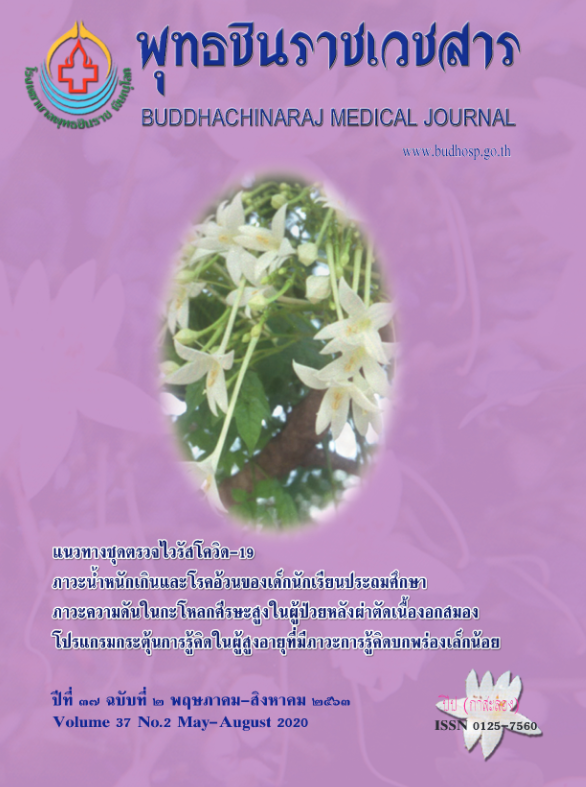ผลการคัดกรองมะเร็งปากมดลูกด้วยวิธี Conventional Pap Smear ที่ยืนยันเป็น LSL/HPV Change กับผลการตรวจชิ้นเนื้อทางพยาธิวิทยา
ผลเซลล์วิทยา LSIL/HPV change กับผลชิ้นเนื้อทางพยาธิวิทยา
คำสำคัญ:
การคัดกรองมะเร็งปากมดลูกด้วยวิธีแพปสเมียร์, เชื้อฮิวแมนแพปพิลโลมาไวรัส, ผลการตรวจ เซลล์วิทยาและพยาธิวิทยา, รอยโรคก่อนมะเร็งชนิดโลเกรดสแควมัสอินทราอิพิทีเรียล/เชื้อฮิวแมนแพปพิล โลมาไวรัส, มะเร็งบทคัดย่อ
มะเร็งปากมดลูกเป็นหนึ่งในมะเร็งไม่กี่ชนิดที่ป้องกันได้ถึงร้อยละ 80 การศึกษาย้อนหลังแบบพรรณนาครั้งนี้เพื่อประเมินความเกี่ยวข้องของการตรวจคัดกรองมะเร็งปากมดลูกด้วยวิธี conventional Pap smear ที่ผลยืนยันเป็น LSIL/HPV change กับผล การตรวจชิ้นเนื้อทางพยาธิวิทยาและอุบัติการณ์การติดเชื้อฮิวแมนแพบพิลโลมาไวรัสของผู้รับบริการตรวจคัดกรองมะเร็งปากมดลูก ด้วยวิธีดังกล่าวที่กลุ่มงานพยาธิวิทยากายวิภาค โรงพยาบาลพุทธชินราช พิษณุโลก ระหว่างวันที่ 1 ตุลาคม พ.ศ. 2559 ถึงวันที่ 30 กันยายน พ.ศ. 2562 จำนวน 16,611 ราย นำเสนอข้อมูลเป็นค่าความถี่และค่าร้อยละ ซึ่งพบผู้ติดเชื้อฮิวแมนแพปพิลโลมาไวรัสร้อย ละ 0.4 พบผู้ป่วยที่ผล Pap smear ยืนยันเป็น LSIL/HPV change 60 คน พบมากที่สุดในช่วงอายุ 30-50 ปี อายุเฉลี่ย 41.56 ปี ซึ่ง 11 คนถูกตัดออกจากการศึกษาเนื่องจากไม่มีผลชิ้นเนื้อทางพยาธิวิทยา คงเหลือผู้ป่วย 49 คนที่ได้รับการยืนยันการวินิจฉัยด้วย ผลชิ้นเนื้อทางพยาธิวิทยา โดยพบผลผิดปกติร้อยละ 75.5 แบ่งเป็น LSIL/HPV change ร้อยละ 46.9, HSIL ร้อยละ 24.5 และมะเร็งร้อยละ 4.1 ซึ่งการตรวจคัดกรองมะเร็งปากมดลูกที่ผลเป็น LSIL/HPV change นั้นโอกาสที่การตรวจชิ้นเนื้อได้ผลเป็นอย่างเดียวกันร้อยละ 46.9 โดยมีช่วงความเชื่อมั่นระหว่างร้อยละ 33.7 ถึง 60.6 สรุปได้ว่า conventional Pap smear ยังเหมาะสมใน การคัดกรองมะเร็งปากมดลูก เนื่องจากทำได้ง่าย ปลอดภัย และราคาถูก เป็นประโยชน์ต่อการป้องกันและเฝ้าระวังเพื่อลดจำนวนผู้ป่วยมะเร็งปากมดลูกรายใหม่และลดอัตราตายจากมะเร็งปากมดลูก
เอกสารอ้างอิง
2. Office of Reproductive Health, Department of Health, Ministry of Public Health. Comprehensive cervical cancer control:A guide to essential practice. Bangkok:Office of Reproductive Health, Department of Health, Ministry of Public Health; 2015.
3 Office of Public Health Policy and Planning, Office of Permanent Secretary, Ministry of Public Health. Summary of important Public Health Statistics 2008-2012. Bangkok:Office of Public Health Policy and Planning, Office of Permanent Secretary, Ministry of Public Health; 2012.
4. Ferlay J, Shin HR, Bray F, Forman D, Mathers C, Parkin DM. Cancer incidence and mortality worldwide: IARC Cancer Base No. 10. Lyon, France: International Agency for Research on Cancer [Internet]. 2018. [cited 2020 June 17]. Available from: http://onlinelibrary.wiley.com/doi/10.1002/ijc. 25516/epdf
5. WHO/ICO. Summary report on HPV and cervical cancer statistics in Thailand. Barcelona: WHO/ICO HPV Information Centre; 2010. p.21-61.
6. World Health Organization. Human papillomavirus (HPV) and cervical cancer [Internet]. 2016. [cited 2020 June 15]. Available from:http://www.who.int/mediacentre/ factsheets/fs380/en/
7. Laivejpittaya S, Chowphothong P, Sangkharat S, Wiriyapak B. Gynecology textbook. Bangkok: Faculty of Medicine Siriraj Hospital; 2011.
8. National Cancer Institue. Cervical cancer screening by Pap smear. 3rd ed. Bangkok: National Cancer Institute; 2007.
9. Tocharoenvanich S. Cervical cancer screening. Songkla Med J 2002;20(2):137-49.
10. Poomtavorn Y. Cervical cancer screening. Bangkok: Thammasat University Publishing;2013.
11. Chrysostomou AC, Stylianou DC, Constantinidou A, Kostrikis LG. Cervical cancer screening programs in Europe the transition towards HPV vaccination and population-based HPV testing. Viruses 2018;10(12):729. doi:10.3390/v10120729
12. Tangsiriwatthana T, Ponampaisathit S, Chainal U, Bunsom K, Witayanun S, Thijug S, et al. Prevalence of human papillomavirus and typed infections in Thai women with normal Pap smear effects. Bull Dept Med Sci 2019;61(2):73-85.
13. Srisomboon J. HPV and cervical cancer. Chiang Mai: Chiang Mai University; 2006.
14. Laowahutanont P. Cervical cancer screening guidelines. Bangkok: National Cancer Institute; 2018.
15. Solomon D, Davey D, Kurman R, Moriarty A, O'Connor D, Prey M, et al. The 2001 Bethesda System terminology for reporting results of cervical cytology. JAMA 2002;287(16):2114-9.
16. Srisomboon J. Cervical cancer. Chiang Mai:Chiang Mai University; 2004.
17. Wangchai W. Cervical cancer screening in women who joined primary cancer screening program. Lampang: Lampang Hospital; 2015.
18. Manmad K. Prevalence of Human Papilloma virus from cervical cancer screening in eastern Thailand. Khonkaen: KhonKaen University; 2010.
19. Kietpeerakool C. Treatment of lesions within the cervical mucosa gynecologic oncology. KhonKaen: KhonKaen University; 2011. p. 94-102.
20. Isranguranaayudhya N. Gynecological cancer. Gynecology textbook. 3rd ed. Bangkok: Mahidol University; 2007.
21. Wilailak S. New strategies for the prevention of cervical cancer. Bangkok:National Defence College; 2017.






